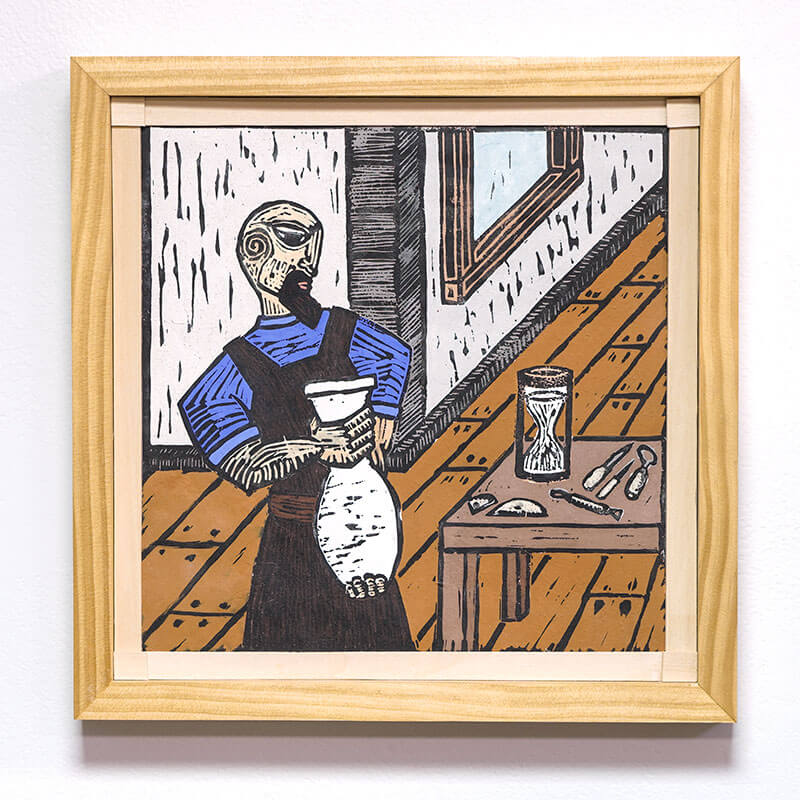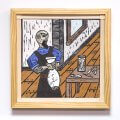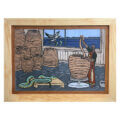
Paul Andrew Wandless was born in Miami, Florida and grew up in Smyrna, Delaware. He earned his Bachelor of Fine Arts in Ceramics and Sculpture from the University of Delaware, a Master of Arts in Ceramics from Minnesota State University- Mankato and then earned his Master of Fine Arts in Ceramics and Printmaking from Arizona State University. He also worked with art historians while earning his MA and MFA to study different styles of writing in the arts. Wandless returned to the greater Philadelphia area after finishing graduate school, where he taught and had his studio for 10 years.
Wandless currently lives and has his studio in Chicago, IL. His sculptures and prints feature ceramic processes, printmaking methods and a wide variety of sculptural techniques and mediums. Clay, printmaking, stone carving, mold making, leather working, metalsmithing, wood carving and painting are all mediums used in combination or individually for creation of his works. His clay work, prints and sculptures have been widely exhibited since 1995, including a solo exhibitions at the Ohr-O’keefe Museum of Art. His art works are published in 18 books and collected privately and publicly.
As a writer, Wandless authored Image Transfer On Clay, 500 Prints On Clay, Image & Design Transfer Techniques and co-authored Alternative Kilns & Firing Techniques and is a contributing author in 10 clay technique books. He’s written 31 published articles for several publications including Pottery Making Illustrated, Ceramics: Art and Perception and the International Review of African American Art. A DVD was also created of Wandless by the American Ceramic Society titled, Fundamentals of Screen Printing On Clay with Paul Andrew Wandless.
Wandless has served on several Boards in different capacities since 2001. He currently serves on the Board of Trustees for Penland School of Art (2015 – ). He served on the Board of Directors for the International Ceramic Artists Network (ICAN) as Vice President, the Board of Directors for the National Council on Education for the Ceramic Arts (NCECA) as a Director-at-Large, the Board of Directors for The Clay Studio of Philadelphia and the steering committee for the Philadelphia Sculptors. He was also an NCECA Presidential Appointee for the Demonstrating Artist Video Program as the first Video Editor/DVD Creator.
Wandless has given 103 workshops regarding his art, techniques and research around the U.S. and Canada. He lectures frequently and sits on panels addressing a wide range of art related topics from technique and process to aesthetics and art theory. He has received recognition for his work and activities in the form of awards from Minnesota State University, Mankato as a recipient of the Distinguished Young Alumni Award and from the National Council on Education for the Ceramic Arts (NCECA) as an Outstanding Achievement Award recipient.
I’m a storyteller and my artwork is a vehicle through which my voice can be seen. As an artist, craftsman and writer, I want to engage and inform the viewer both visually and intellectually through the mediums and processes I employ. My personal philosophies and concerns manifest themselves as musings, stories or philosophical statements. These conceptualized ideas then take physical form as visual narratives through my work. This often manifests as figurative art or pictorial scenes.
My clay prints and prints on paper tell stories or share insights through printed images. My mythologized philosophy, symbology and narratives are manifested in pictorial format to visually and intellectually engage the viewer. The clay prints and the prints on paper are the most direct interpretations of my writings. The pictorial format also allows for the use compositional geometry to imbed multiple layers of coded information. Compositional arrangements of the objects and the symbolism of the imagery, contained in the prints, are for the viewer to decipher and further interpret the narratives for each.
As a Black Artist, Craftsman and Writer, I strive to engage and inform the viewer both visually and intellectually from my point of view that’s been filtered through my own personal experiences. I want to leave something to think about from the dialogue or storytelling occurring between the viewer and me through my work. Then hopefully, due to this shared experience, the person will feel a commonality or recognition of the narrative I’m communicating through my art.






